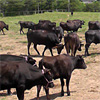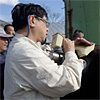
Monograph
MonographRadiation Protection Information Center
Current State of Radiation Doses in Fukushima Prefecture: No Health Risk, Calling for Institution of Scientific Measurements and Correction to Foolish Policy
COLUMNRADITATION
 Photograph of Cattle
Photograph of Cattle
Since the tsunami and ensuing reactor accidents at Fukushima Dai-Ichi Nuclear Power Plant in March last year, the author has freely conducted, as a scientist in the discipline of radiological protection science, on-site radiological hygiene surveys in an autonomous format apart from any organization. In the beginning, the most feared short-term nuclear hazard (risk factor) was considered to be thyroid doses from radioactive iodine. Tests were completed in April in last year for 40 evacuees from Namie-machi plus residents from the city of Nihonmatsu and Iitate Village. The results of these 66 individuals confirmed low doses of 8 mSv or less, approximately one thousandth of the Chernobyl accident’s maximum thyroid radiation dose of 50 Sv.
(First published in "Global Energy Policy Research" on October 1, 2012)
Fukushima: Neither Chernobyl, Nor Hiroshima
COLUMNRADITATION
 Jun Takada
Jun Takada
Flooded by the large tsunami of 3.11, the Fukushima Dai-Ichi Nuclear Power Plant lost its cooling function, which caused its nuclear fuel to melt partially. Subsequently, hydrogen explosions outside the containment vessels caused the release of mainly radioactive gases, which contaminated Fukushima Prefecture and neighboring regions.
(First published in "Global Energy Policy Research" on February 20, 2012)
The path to reconstruction in Fukushima, as seen through fieldwork in Eastern Japan
COLUMNRADITATION
 Jun Takada
Jun Takada
Former Prime Minister Naoto Kan fanned the flames of fear regarding the “danger” of nuclear power. In this he was assisted by left-wing liberals and scholars who were perched firmly on the fence rather than taking sides. These flames were stoked by a large segment of the media, which sparked mass hysteria across Japan in regards to radiation levels and psychological torment in Fukushima Prefecture. Newspapers were still fomenting fear even five months after the earthquake by using meaningless numbers, such as reporting that the cesium in Fukushima was 168 times that of the bomb dropped on Hiroshima. Yet in 1945, not one person died because of cesium. The dose of radiation from nuclides with half-life of 30 years is so small as to be unworthy of consideration. Radioactivity is inversely proportional to half-life, so radiation from nuclides with a short half-life of seconds or minutes was dangerous. The Nuclear and Industrial Safety Agency (NISA) is uninformed when it comes to these fundamentals regarding damage caused by nuclear explosions, and the news media simply goes along with what the NISA tells them, showing the depths of their ignorance.
(First published in "the fourth "True Interpretations of Modern History " essay contest. on Octorber 1, 2012)









